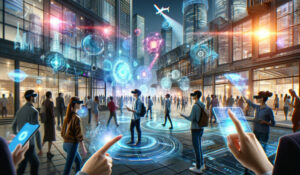In today’s digital age, the way we read and interact with books is evolving. Augmented Reality (AR) books are at the forefront of this evolution. But what exactly are they? Simply put, AR books are traditional print books enhanced with digital technology. They come to life when viewed through a smart device, offering an interactive experience that leaps off the page.
How Do Augmented Reality Books Work?
The magic of AR books lies in the blend of physical and digital. These books contain printed elements that, when scanned with a smartphone or tablet, trigger digital overlays. These overlays can be animations, videos, 3D models, or interactive games that appear on the device’s screen, superimposed over the real-world image of the book’s page.
The Role of AR Apps
To access the augmented features, you’ll need an AR app. These apps use your device’s camera to recognize specific triggers in the book, like images or QR codes. Once recognized, the app displays the corresponding digital content, making it seem as though it’s part of the physical book.
The Benefits of Augmented Reality Books
Augmented reality books are more than just a cool tech novelty; they offer several benefits, especially in educational settings.
Enhancing Learning Experiences
AR books have the incredible potential to transform the way kids and students engage with learning materials. For younger readers, AR books turn reading into an exciting and interactive adventure. These books can take static images and text and bring them to life with animations, sounds, and interactive elements. This not only captures a child’s attention but also makes learning more enjoyable and effective.
Consider a biology book that uses AR to turn the pages into a virtual journey through the human body. Instead of just reading about the circulatory system, students can witness it in action as blood cells flow through the arteries and veins. This dynamic visualization helps students grasp complex concepts with greater ease.
In the realm of history, AR books can transport students back in time. Instead of reading about historical events, they can witness them through augmented reenactments. Imagine reading about the American Revolution and then using AR to witness the Boston Tea Party or George Washington crossing the Delaware River. This immersive experience not only makes history come alive but also enhances comprehension and retention. The educational potential of AR books is immense. They have the power to make learning more engaging, memorable, and effective, making them a valuable resource for both teachers and students.
Encouraging Reading and Exploration
AR books can reignite the passion for reading in a generation that’s growing up digital. They offer an exciting, new way to explore stories and subjects, potentially drawing in reluctant readers who might find traditional books less engaging.
Types of Augmented Reality Books
Children’s Storybooks
AR technology in children’s books can bring stories to life. Characters can jump off the page, and interactive elements can add layers to the storytelling, making it a captivating experience for young readers.
Educational Textbooks
In educational textbooks, the integration of augmented reality (AR) opens up a world of possibilities for enhancing the understanding of complex concepts in various subjects such as science, geography, and history. AR can serve as a dynamic tool that goes beyond static illustrations and written explanations.
- Science Simplified: AR can bring scientific concepts to life by providing interactive 3D models of molecules, cells, and organisms. Students can explore the intricate structures and processes that might otherwise be challenging to comprehend through traditional static diagrams;
- Geography Exploration: Geography textbooks can utilize AR to create virtual tours of geographical features, landmarks, and even entire countries;
- Historical Time Travel: In history textbooks, AR can transport students to pivotal moments in the past. They can witness historical events, explore ancient civilizations, and even interact with historical figures through immersive reenactments;
- Mathematical Visualization: AR can aid in visualizing complex mathematical concepts. It can provide interactive graphs, 3D geometry models, and step-by-step problem-solving guides, making math more accessible and engaging;
- Language Learning: Language textbooks can incorporate AR to facilitate language acquisition. Interactive dialogues, pronunciation guides, and real-world language use scenarios can be brought to life through AR;
- Environmental Awareness: AR can help raise environmental awareness by illustrating concepts related to ecosystems, climate change, and conservation. Students can witness the impact of environmental issues in real time;
- Art Appreciation: Art history textbooks can use AR to display famous artworks in 3D, allowing students to examine them from different angles and gain a deeper appreciation for artistic techniques;
- Interactive Historical Maps: History and geography textbooks can feature interactive historical maps that show how borders and territories have changed over time, providing valuable context to historical events.
These examples showcase how AR can revolutionize educational textbooks, making abstract or challenging subjects more accessible, engaging, and interactive for students of all ages. As technology continues to advance, the potential for AR in education is limitless, promising a brighter future for learners worldwide.
Interactive Manuals and Guides
AR can also enhance manuals and guides. Imagine a car manual where you can see a 3D model of an engine and interact with it to learn about different parts, or a cookbook where recipes come to life with video demonstrations.
The Creative Process Behind AR Books
Creating an AR book isn’t just about writing and illustration; it involves a blend of storytelling, graphic design, and technology.
Collaboration Between Authors, Artists, and Developers
The process of creating an AR book is a fascinating blend of art, storytelling, and technology, requiring a collaborative effort from a diverse team. Authors play a crucial role, not only in crafting the narrative but also in envisioning how augmented elements can enhance their story. They need to think beyond traditional storytelling, considering how digital interactions can complement and expand their narrative.
Artists then bring this vision to life, creating visuals that are not just illustrations but interactive elements that will engage readers in a new way. This involves a deep understanding of both art and technology, as these visuals need to be designed for seamless integration with augmented reality.
Developers are the technical backbone in this process. They work closely with both authors and artists to ensure that the digital components of the AR book function flawlessly. This includes programming interactions, animations, and ensuring compatibility with AR platforms and devices. The developers’ expertise is crucial in making the augmented content not just functional but also accessible and user-friendly. This teamwork is essential to create a cohesive experience where the story and augmented content complement each other. The goal is to ensure that the augmented elements don’t overshadow the narrative but rather enrich it, making the AR book a unique and engaging product that stands out in the evolving landscape of digital media.
Designing for Interactivity
The design process involves thinking about how readers will interact with the book. It’s not just about what looks good on the page but also about how elements will function in a digital space.
Challenges and Considerations
While AR books offer exciting possibilities, there are challenges to consider.
- Cost and Accessibility. Creating AR books can be expensive, and not everyone has access to the devices needed to experience them fully. This can limit their accessibility and use, especially in under-resourced communities;
- Balancing Technology and Reading. It’s important to balance the use of technology with the essence of reading. The goal is to enhance the reading experience, not overshadow it with digital elements.
The Future of Augmented Reality Books
The potential of AR books is vast, and we’re just scratching the surface. As technology advances, we can expect more immersive and interactive experiences.
Innovations in AR Technology
As we look towards the future of augmented reality (AR) books, the potential advancements in technology are truly exciting. Imagine AR books that utilize advanced gesture recognition, allowing readers to interact with the story and its characters in a much more dynamic way. This could mean turning pages with just a wave of a hand or activating animations and sounds through specific movements, creating a highly interactive reading experience.
Additionally, the integration of AR books with virtual reality (VR) could redefine the concept of immersive storytelling. Picture donning a VR headset and finding yourself in the very setting of the book, surrounded by its characters and environment. This integration would not only enhance the visual aspect but also add a new dimension to the sensory experience of reading. Such advancements could make reading a more engaging activity for all age groups, particularly for younger readers who are more attuned to interactive and multimedia content. It could also revolutionize educational materials, making learning more interactive and engaging, thereby enhancing retention and understanding.
In essence, the future of AR books lies in seamlessly blending the physical and digital worlds, offering experiences that are not just about reading a story but living it. This evolution will undoubtedly transform how we perceive and interact with books, making them more than just a source of information or entertainment but a gateway to immersive, interactive experiences.
Expanding Genres and Audiences
As augmented reality (AR) technology continues to advance and become increasingly accessible and affordable, its integration into various genres of literature is on the horizon. While AR has primarily been associated with educational materials and interactive textbooks, its potential extends far beyond the realm of academia. Here’s a glimpse into how AR could revolutionize different genres of literature:
- Interactive Novels: Imagine reading a suspenseful thriller where you can visually explore crime scenes, examine evidence, and even make choices that affect the outcome of the story. AR can transform traditional novels into immersive, choose-your-own-adventure experiences;
- Children’s Books: AR-enhanced children’s books can captivate young readers with animated characters and interactive elements. These books could promote early literacy skills by allowing kids to engage with the story through touch and exploration;
- Travel Guides: Travel enthusiasts can benefit from AR travel guides that provide real-time information, historical context, and virtual tours of landmarks. It’s like having a personal tour guide in your pocket;
- Cookbooks: AR can guide home chefs through recipes with step-by-step visual instructions and even offer 3D views of culinary techniques. Cooking becomes more accessible and enjoyable with interactive cookbooks;
- Art and Photography Books: For art aficionados, AR can enrich art and photography books by providing augmented exhibitions. Readers can view famous artworks in their actual size and explore the creative process behind the images;
- Biographies and Autobiographies: Personal stories can come to life with AR, featuring interviews, videos, and archival materials related to the subject’s life. Readers can delve deeper into the lives of historical figures or contemporary icons;
- Science Fiction: AR can take science fiction to the next level by creating virtual worlds and interactive alien species. Readers can immerse themselves in futuristic landscapes and technology.
The future of literature is poised to be a blend of traditional storytelling and interactive digital elements, making reading a more engaging and immersive endeavor for readers of all genres and ages. As AR technology continues to evolve, the possibilities for creative and interactive storytelling are limitless, promising exciting developments in the world of literature.
Conclusion: A New Realm of Reading
Augmented reality books represent a new frontier in reading and education. They offer a unique way to combine traditional reading with the interactive and immersive capabilities of digital technology. As this technology continues to evolve, we can look forward to even more innovative and engaging reading experiences. Whether you’re a tech enthusiast, a parent, or an educator, AR books are worth exploring as they open up new worlds of imagination and learning.


Average Rating